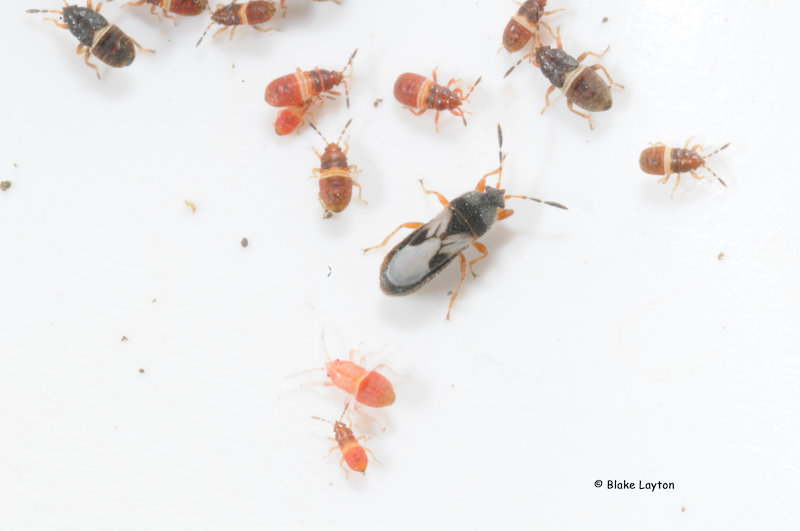Southern Chinch Bugs, Vol. 7, No. 17
Related News
April 11, 2013
April 2, 2013
March 14, 2013
February 28, 2013

There’s a big patch of dead grass in the middle of the yard and it is getting bigger by the week. What is causing this problem? If this is a St. Augustine lawn, chinch bugs may be the culprits. Chinch bugs are the most important insect pests of St. Augustine grass, but don’t start treating until you are sure chinch bugs really are the cause of the problem. There are several diseases that cause similar symptoms, and insecticides will not control disease problems.
Check for chinch bugs by getting down on your knees and using your fingers to dig through leaves, stems and thatch at the edge of the dying grass—where the grass is still green or just beginning to yellow. Better yet, take a one-gallon metal can that has had the bottom cut out, or a large diameter piece of PVC pipe, force it into the turf, fill it with water, and check for floating chinch bugs. Look carefully, these are small insects. But it takes around 20+ chinch bugs per square foot to kill grass, so chinch bugs should be relatively easy to find if they are the cause of the problem.
Chinch bug outbreaks are more likely during periods of hot, dry weather, and St Augustine grass growing in full sun is more susceptible than St. Augustine grass that receives some shade. This photo shows a single adult chinch bug (about 1/8 to 3/16 inch long) a couple of dark-colored older nymphs, and several of the younger, red-colored nymphs. Both nymphs and adults feed on stems and stolons with piercing-sucking mouthparts, but it the toxic saliva they inject into the plants while feeding that kills the grass. Although chinch bugs are primarily pests of St. Augustine lawns, they sometimes damage Zoysia and other turf grasses.
Control: Water the grass the day before treating; this forces the bugs to move closer to the surface where the insecticide can reach them more readily. Then spray with a lawn insecticide containing an active ingredient such as bifenthrin, cyfluthrin, lambda-cyhalothrin, or permethrin using a hose-end sprayer or some type of broadcast sprayer. Finish by watering lightly after treatment, no more than 1/8 to ¼ inch, to wash the spray into the thatch area where the chinch bugs are most active. Don’t water too heavily or you will wash the insecticide past the bugs. For best control of heavy infestations apply a second treatment two weeks later. Granular insecticides are also a good option but be sure to water in according to label directions. Products that contain clothianidin (Arena) will control chinch bugs that are resistant to the pyrethroid insecticides listed above.
See page 5 of Extension Publication 2331, Control Insect Pests in and around the Home Lawn for more information:
For information on chinch bug control in commercial turf, see page 6 of Extension Publication 1858, Insect Control in Commercial Turf.
Blake Layton, Extension Entomology Specialist, Mississippi State University Extension Service.
The information given here is for educational purposes only. Always read and follow current label directions. Specific commercial products are mentioned as examples only and reference to specific products or trade names is made with the understanding that no discrimination is intended to other products that may also be suitable and appropriately labeled.
Mississippi State University is an equal opportunity institution.
Bug’s Eye View is now on Facebook. Join the Bug's Eye View Facebook group here.